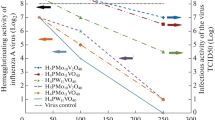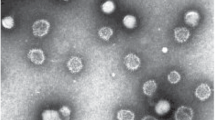Summary
Infection of HeLa-cell monolayer cultures with rabbit poxvirus induces a marked decrease in cell-associated protein and in the activities of lactate dehydrogenase, acid phosphatase, and β-glucuronidase. This effect begins to occur around 10 hours post-infection (p.i.) and is accompanied by a concomitant rise of these enzyme activities in the culture medium. Only few cells detach from infected monolayers and these cannot account for protein release. Virion release can be inhibited at 4° C, whereas protein release cannot and it seems therefore that these events do not happen by a common mechanism. Moreover, penetration studies with [14C]-sucrose indicate that protein release reflects a true increase in plasma membrane permeability. Using the Gomori stain for acid phosphatase, a release of the enzyme into the cytoplasm around 8 hours p.i. can be confirmed rendering a causative role of lysosomal hydrolases in the pathogenesis of the observed plasma membrane permeability changes possible but not proving it.
Similar content being viewed by others
References
Allison, A. C., Mallucci, L.: Histochemical studies of lysosomes and lysosomal enzymes in virus-infected cell cultures. J. exp. Med.121, 463–476 (1965).
Allison, A. C., Sandelin, K.: Activation of lysosomal enzymes in virus-infected cells and its possible relationship to cytopathic effects. J. exp. Med.117, 879–887 (1963).
Bergmeyer, H. U., Bernt, E., Hess, B.: Lactatdehydrogenase. In:Bergmeyer, H. U. (ed.), Methoden der enzymatischen Analyse, 737–743. Weinheim: Verlag Chemie 1962.
Blackman, K. E., Bubel, H. C.: Poliovirus-induced cellular injury. J. Virol.4, 203–208 (1969).
Brunk, U. T., Ericsson, J. L. E.: The demonstration of acid phosphatase inin vitro cultured tissue cells. Studies on the significance of fixation, tonicity and permeability. Histochem. J.4, 349–363 (1972).
Choppin, P. W., Klenk, H. D., Compans, R. W., Caliguiri, L. A.: The para-influenza virus SV5 and its relationship to the cell membrane. In:Pollard, M. (ed.), Perspectives in Virology, Vol. VII, 127–156. New York: Academic Press 1971.
Fishman, W. H.: β-Glucuronidase. In:Bergmeyer, H. U. (ed.), Methoden der enzymatischen Analyse, 869–874. Weinheim: Verlag Chemie 1962.
Gaush, C. R., Youngner, J. S.: Lipids of virus-infected cells. II. Lipid analysis of HeLa cells infected with vaccinia virus. Proc. Soc. exp. Biol. Med.112, 1082–1085 (1963).
Gilbert, V. E.: Enzyme release from tissue cultures as an indicator of cellular injury by viruses. Virology21, 609–616 (1963).
Hopwood, D.: Theoretical and practical aspects of glutaraldehyde fixation. Histochem. J.4, 267–303 (1972).
Itzhaki, R. F., Gill, D. M.: A micro-biuret method for estimating proteins. Anal. Biochem.9, 401–410 (1964).
Katzman, J., Wilson, D. E.: Newcastle disease virus-induced plasma membrane damage. J. gen. Virol.24, 101–113 (1974).
Linhardt, K., Walter, K.: Phosphatasen. In:Bergmeyer, H. U. (ed.), Methoden der enzymatischen Analyse, 779–787. Weinheim: Verlag Chemie 1962.
Miyamoto, H., Kato, S.: Immune hemadsorption by cells infected with pox-viruses. Biken J.11, 343–353 (1968).
Norkin, L. C.: Cell killing by simian virus 40: Impairment of membrane formation and function. J. Virol.21, 872–879 (1977).
Norkin, L. C., Ouellette, J.: Cell killing by simian virus 40: Variation in the pattern of lysosomal enzyme release, cellular enzyme release, and cell death. J. Virol.18, 48–57 (1976).
Reeves, M. V., Chang, G. C. H.: Studies on lysosomal acid phosphatase in virus infected Hep-2 cells. Microbios4, 167–179 (1971).
Silverstein, S.: Macrophages and viral immunity. Semin. Hematol.7, 185–214 (1970).
Stokes, G. V.: High-voltage electron microscope study of the release of vaccinia virus from whole cells. J. Virol.18, 636–643 (1976).
Ueda, Y., Ito, M., Tagaya, I.: A specific surface antigen induced by poxviruses. Virology38, 180–182 (1969).
Weintraub, S., Dales, S.: Biogenesis of poxviruses: Genetically controlled modification of structural and functional components of the plasma membrane. Virology60, 96–127 (1974).
Wolff, D. A., Bubel, H. C.: The disposition of lysosomal enzymes as related to specific viral cytopathic effects. Virology24, 502–505 (1964).
Author information
Authors and Affiliations
Additional information
With 2 Figures
Rights and permissions
About this article
Cite this article
Schümperli, D., Peterhans, E. & Wyler, R. Permeability changes of plasma and lysosomal membranes in HeLa cells infected with rabbit poxvirus. Archives of Virology 58, 203–212 (1978). https://doi.org/10.1007/BF01317602
Received:
Accepted:
Issue Date:
DOI: https://doi.org/10.1007/BF01317602




